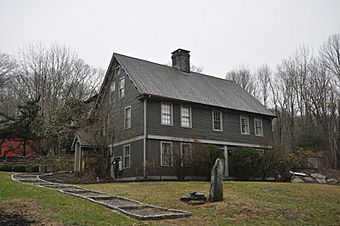Parmelee House (Killingworth, Connecticut) facts for kids
Quick facts for kids |
|
|
Parmelee House
|
|
 |
|
| Location | 4 Beckwith Rd., Killingworth, Connecticut |
|---|---|
| Area | 6 acres (2.4 ha) |
| Built | c. 1770 |
| Architectural style | Colonial |
| NRHP reference No. | 07000417 |
| Added to NRHP | May 15, 2007 |
The Parmelee House is a very old and special home located in Killingworth, Connecticut. It was built around 1770, which means it's over 250 years old! This house is important because it shows how people in the 1700s sometimes changed farm buildings into homes. It's a great example of Colonial architecture, a style popular when America was first forming. In 2007, it was added to the National Register of Historic Places, which means it's a really important historical site.
Contents
What is the Parmelee House?
The Parmelee House is found in a quiet, country part of western Killingworth. It sits on the east side of Beckwith Road. This house is made of wood and has two and a half stories. It has a roof that slopes down on two sides, and a chimney right in the middle.
Unique Design Features
Because the house is built into a hill, it looks like it only has one story from the back! Even though it looks like a typical old colonial house, its inside layout is quite unusual for its time. Part of this is because what would normally be a basement was actually used as a living space. This makes the house very interesting to study for people who like old buildings.
A House with a Secret Past
The Parmelee House was likely built around 1770 by Ezra Parmelee. His family were some of the very first settlers in the area. What makes this house truly special is how it might have started. Experts believe it was first built as a three-bay bank barn. A bank barn is a type of barn built into a hillside, so you can enter different levels from the ground.
From Barn to Home
The way the fireplaces are built suggests that the building was changed into a home after the American Revolutionary War. This probably happened in the late 1780s. Records from 1770 don't mention a house on the property, but by 1787, a house is clearly there. This helps us guess when the big change happened. The Parmelee family owned this property for most of the years until 1928. There is also another barn on the property that was built around 1880.



